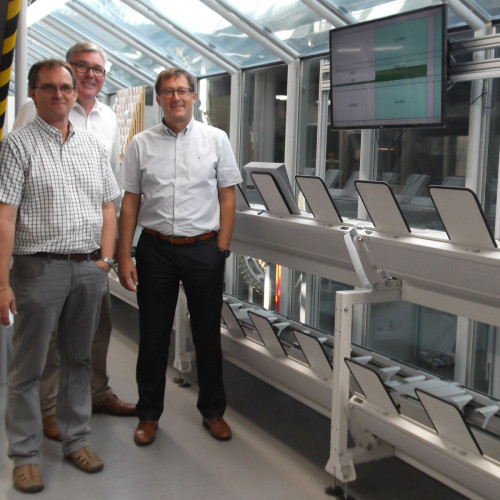
Plate automation has proved it's worth - a field report from Heilbronner Stimme

In today’s market environment, printers have to be flexible enough to react to very tight time lines and – at the same time – be able to fulfill even the highest demands in terms of output and quality. In this context, automation can be a decisive factor and at Heilbronner Stimme, this was particularly true for the pre-press department after a new press had been installed in 2014. Competent partners were needed in order to fully utilize the new presses’ speed and efficiency.
Heilbronner Stimme was founded in 1946 as a newspaper publishing company. Today it is the parent house of a modern, versatile and still family-led media group. Six hundred employees work at its print facility in Heilbronn, where 250,000 printing plates are consumed per year. With the newspaper being published on 300 days per year, the daily plate consumption lies at approx. 830 plates. Nine regional editions and various advertising journals are produced regularly.
In 2014, Heilbronner Stimme decided to invest in a new press, a KBA Commander CL equipped with an automatic plate changer. The capacity of the new press and the fast plate changes required that further automation steps in the pre-press department were realized in order for plate production to keep up with the presses’ speed. First and foremost, manual plate sorting had to be eliminated and the sorted plates had to be delivered as closely to the new press as possible. Manual plate handling as it had been practiced before was inacceptable, i.e. sorting the plates by hand for each print job, stacking them on trolleys and rolling them to the press room, where they were manually fitted on the press cylinders. The entire process had to be rethought.
At the same time, all capacities had to be checked and the option of introducing new CtP devices with higher plate throughput be evaluated. During the first stage of the project, there were also two plate formats that had to be processed.
Hence the automation project triggered a complete re-evaluation of the established production processes and their adaptation to the new environment. “A high level of automation also bears certain risks” explains Juergen Mueller, Printing Plant Manager at Heilbronner Stimme, “because it diminishes the flexibility in the work processes and makes manual interference difficult, if not impossible.” In Heilbronn, the entire process of plate production was reconsidered. “On the new press, printing plates are always fed into the plate changer in a set of four plates that are mounted vertically above each other. The new plate sorting logic had to take this into account and, at the same time, provide more flexibility and a certain leeway”, says Mueller. “We used each opportunity to discuss the situation internally and also externally with our proven suppliers and, finally, we were able to develop our own new logic.”
Today, Heilbronner Stimme uses Agfa CtP-devices, offset plates and software (Arkitex), paired with register punching and bending systems (VCPevolution HS 800) and a plate transport system with plate sorter directly in the press control room from NELA. The plates are now automatically sorted according to print job and print unit, including completeness check and status indication on a large screen right by the sorter.
The software solutions from Agfa Graphics allow for an automation of various processes, so that manual interference is a thing of the past. The level of automation is determined by Heilbronner Stimme according to their requirements. The workflow was set up for plate imaging by print job, plate sequence according to print unit, and automated start of imaging.
Arkitex Production with its modular design offers individual automation levels. An integration of the printing press with Arkitex Production creates added value in the plate production. A 2D-barcode is imaged in the non-printing area of the plates. This barcode includes information such as job number, number of plates for the job, press unit. The imaged plates are transported directly to the press control room and sorted by print job or press unit. With the information from the 2D-barcode, the plates are always sorted correctly and in the required sequence for the automatic plate changer. Sorting can be static or dynamic, and the sorter is split up into several “stations” so that plates for several print jobs can be produced at the same time. The press operators just have to take the pre-sorted plates to the press. As soon as one “station” is emptied completely, a signal is sent to start imaging the next job in line – “just in time” and without any manual handling.
„We have taken a lot of time to question our own processes and routines, which, in our opinion, is absolutely necessary in order to create added value through an investment like this,” resumes Hans-Juergen Mueller. “We focused on the efficiency of our processes and also tried to consider future developments of the industry. First of all I need to know where I stand and where I want to go and then I can start looking for the right solution.” Asked whether Heilbronner Stimme had reached its goals, Mueller responds with a definite “Yes” and emphasizes again that, with Agfa and NELA he had strong partners on his side who accompanied him through the entire project. Today, man-less production from pre-press to press control room is reality and all automatic processes are fully integrated.